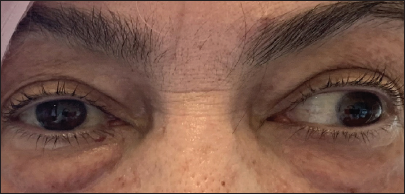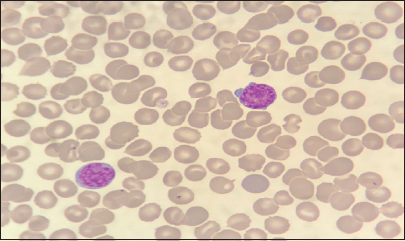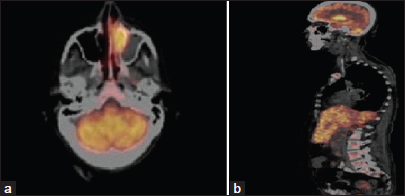Translate this page into:
Extranodal T/NK lymphoma nasal type: A case with thrombotic thrombocytopenic purpura-like syndrome and third cranial nerve palsy
*Corresponding author: Aysun Halacoglu, Department of Hematology, Istanbul Aydin University Faculty of Medicine, Medicalpark Florya Hospital, Istanbul, Turkey. aysunhalacoglu@hotmail.com
-
Received: ,
Accepted: ,
How to cite this article: Halacoglu A. Extranodal T/NK lymphoma nasal type: A case with thrombotic thrombocytopenic purpura-like syndrome and third cranial nerve palsy. J Hematol Allied Sci. 2025;5:109-10. doi: 10.25259/JHAS_22_2024.
Dear Editor,
Extranodal T/NK lymphomas (ENKTL) nasal type is an aggressive form of non-Hodgkin lymphoma. T-cell and NK-cell lymphomas are classified into three categories: 1-Aggressive NK-cell leukemia (ANKL), 2-Systemic Ebstein–Barr virus + T-cell lymphoma of childhood, and 3-ENKTL.[1]
Thrombotic thrombocytopenic purpura (TTP) is characterized by microangiopathic hemolytic anemia and thrombocytopenia associated with brain and kidney dysfunction. It occurs due to a disintegrin and metalloproteinase with thrombospondin type 1 motif, member 13 (ADAMTS-13) deficiency. TTP-like syndrome occurs with similar hematologic changes and additional organ dysfunction syndromes. TTP-like syndrome occurs in critical illnesses such as infection, sepsis, cancer, drugs, toxins, complications of pregnancy, surgery, and transplant.[2]
A 65-year-old female was admitted to the hospital with high fever, anemia, thrombocytopenia, right eye ptosis, and diplopia. Physical examination revealed ptosis and lack of gaze to the medial in the right eye. The liver and spleen were palpable 2-3 cm below the costal line. Neutrophils 4.6 × 109/L, lymphocytes 2 × 109/L, platelets 61 × 109/L, and hemoglobin 8.6 g/dL were detected in complete blood count. Lactate dehydrogenase (LDH): 1923 U/L (240–450U/L), t-bilirubin: 1.85 mg/dL (<1.2 mg/dL), indirect bilirubin: 1.21 mg/dL (<0.8 mg/dL), haptoglobin <1 mg/dL (35–250), creatinine: 1.4 mg/dL (0.5–1.2 mg/dL), and coagulation tests were normal. At the first evaluation, there were 4–5 schistocytes in each area in the peripheral smear. We took blood samples for ADAMTS-13 after that, we immediately started plasmapheresis with the pre-diagnosis of TTP. On the 3rd day of plasmapheresis, it was declined to LDH: 920U/L. The activity of ADAMTS-13: 29.47% (40–130%) was low, the antigen level was normal, and the inhibitor was negative. After the plasmapheresis 5th day, ptosis was cured but restricted medial gaze on the right eye [Figure 1]. Cranial magnetic resonance and angiography results were normal. On the 5th day of the treatment, LDH level (1040U/L) was high. Due to this, the peripheral smear was done again. Peripheral blood smear shows atypical cells with large, irregularly folded nuclei with distinct nucleoli [20%; Figure 2]. The bone marrow (BM) biopsy revealed a marrow infiltrated by atypical medium-sized lymphoid cells, CD43+, CD3+, EBER+ CD56+, granzyme-B+ and TdT, CD34, CD20, and cyclin-D1 negative of an NK/T cell leukemia/lymphoma. The cerebrospinal fluid had atypical cells and immunophenotype was performed CD3 and CD56 positive. On positron emission tomography-computed tomography (PET-CT), the left ethmoid sinus, soft-tissue density (SUVmax: 7.45), and hepatosplenomegaly diffuse high BM involvement was detected (SUVmax: 9 and 10.8, respectively) [Figure 3a and b].

- Restricted medial gaze on the right eye.

- Peripheral blood smear showing atypical cells with large, irregular folded nuclei with non-distinct nucleoli.

- (a) Left ethmoid sinus involvement in positron emission tomography computed tomography (PET-CT). (b) Liver, spleen, and bone marrow involvement in PET-CT.
She was planned to have SMILE protocol (dexamethasone, methotrexate, ifosfamide, L-asparaginase, and etoposide), but the patient did not accept it.
ENKTL often involves the nose and nasopharynx; however, the most common sites of ANKL infiltration include the skin and other organs.[3] In our case, ethmoid sinus involvement and immunophenotype are alike with the ENKTL nasal type. Multiple involvements on PET-CT and blastic cells seen on serial peripheral smears were similar to ANKL.
In the literature,[4] the case of ANKL with multiple cranial nerve palsy has been seen, but our case is the first and only third cranial nerve palsy ENKTL presented in the literature. The patient’s third nerve-palsy symptoms would react to intense chemotherapy.
TTP-like syndrome has been seen with solid tumors in previous cases. Our patient is the first case in the literature to present with TTP-like syndrome and diagnosed with ENKTL. A series of peripheral smears and BM examination may help to diagnose TTP-like syndrome etiology correctly.
Ethical approval
The Institutional Review Board approval is not required.
Declaration of patient consent
The authors certify that they have obtained all appropriate patient consent.
Conflicts of interest
There are no conflicts of interest.
Use of artificial intelligence (AI)-assisted technology for manuscript preparation
The author confirms that there was no use of artificial intelligence (AI)-assisted technology for assisting in the writing or editing of the manuscript and no images were manipulated using AI.
Financial support and sponsorship: Nil.
References
- WHO classification of tumours of haematopoietic and lymphoid tissues 4th ed Lyon, France: IARC Press; 2017.
- [Google Scholar]
- TTP-like syndrome: Novel concept and molecular pathogenesis of endotheliopathy-associated vascular microthrombotic disease. Thromb J. 2018;16:20.
- [CrossRef] [PubMed] [Google Scholar]
- Extranodal NK/T-cell lymphoma, nasal type: Clinical features, outcome, and prognostic factors in 101 cases. Eur J Haematol. 2018;101:379-88.
- [CrossRef] [PubMed] [Google Scholar]
- CD56-negative aggressive NK cell leukemia relapsing as multiple cranial nerve palsies: Case report and literature review. Case Rep Hematol. 2017;2017:3724017.
- [CrossRef] [PubMed] [Google Scholar]





